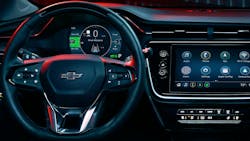Driving EVs Long Distances: Difficult yet Doable
I’ve owned a Chevrolet Bolt electric car for more than a year, but until June, I’d never taken it on a long trip. A 220-mile roundtrip to visit my daughter in college last year was the only outing beyond my typical short commute. Last month, however, I drove it from Cleveland to Chicago, then later took a trip from Chicago to Indianapolis and back.
Here are a few things that I learned:
Range Anxiety Is Real
I drove gasoline cars across West Texas and New Mexico in my youth, knowing that when I left a gas station, I wouldn’t see another for a few hundred miles. So, I’m not sure what made it so much worse to watch the miles-left counter on my Bolt shrink. Maybe, it was seeing numbers instead of just watching a dial move slowly counterclockwise.
The Bolt’s gauge has three numbers – range in the best-case scenario, the typical range for the remaining charge and the remaining charge if you blast the air conditioning and drive like a moron. Range anxiety had me obsessing about the worst-cast scenario and planning my stops accordingly.
And, I avoided AC, even when I really needed some air.
Public Chargers Aren’t That Bad
A year ago, there were a lot of stories about how hard it was to use the various non-Tesla EV charging networks. You typically pay via app, and each company has a different app, forcing drivers to have several on their phones. Plus, many EV charging stations don’t work either due to vandalism (theft of copper wires is a massive problem) or poor maintenance.
I didn’t experience any of those challenges, other than one of two stations in Indiana had a broken clip on its charger, preventing my car from recognizing that the cable was plugged in. My solution – move to the working side of that station. The app issue remains, but I had already downloaded the two most popular options. And, some chargers now allow you to pay with a credit card instead of only via the app, including one in a Wal-Mart parking lot that I used.
However…
Charging Speed Matters… A Lot
The Bolt is one of the slowest-charging EVs on the market, and that led to certain challenges.
First, some technical stuff. Most modern EVs have three charging options:
- Level 1 uses a standard wall plug. Filling a 65kwh battery takes several days.
- Level 2 uses a 240-volt plug, like the type used for dryers and electric ranges. Filling a 65kwh battery takes about eight hours.
- Level 3 fast-chargers use electrical equipment not available in homes.
Tesla, Hyundai, Ford, VW and GM EVs using newer batteries can fast-charge up to about 80% of their battery’s capacity in 30 minutes on a Level 3 charger. My car with its older battery tech takes more than double that.
At my first stop to recharge when driving from Cleveland to Chicago, I parked behind a Chevy dealership along the turnpike, where I was able to access an ABB Level 3 charger. I walked to a nearby restaurant and had a leisurely meal while the juice flowed. After about an hour, the charge level had reached 80%, but I wanted more power given that I still had a long way to go. That’s when a father with an infant daughter pulled into the parking lot in a new Rivian SUV.
Getting from 80% to full would have taken at least another hour (batteries aren’t linear like gas tanks), and I didn’t want to make someone else wait so long to use the only fast-charger in the whole small town, so I left with enough charge to finish the trip, if all went well.
Slow Down!
This was a tough one, and it ties back to range anxiety. Up to 60 mph, driving the Bolt was as comfortable as driving any of my old gasoline-powered cars. But, as I went faster, the colored dial around my speedometer shifted from green to yellow, a sign that I was burning electricity faster than I should.
In city driving, I can top 5 miles per kwh of electricity. Even at 60mph, I can get around 4.5 miles per kwh. At 70, the speed limit on the Ohio and Indiana turnpikes, I was getting closer to 3 miles per kwh. After charging at the midway point, I did the math and realized that I could make it the rest of the way to Chicago (where a friendly electrical outlet was waiting) without stopping again … as long as I stuck with the trucks in the right lane. A little more math told me that it would be significantly faster (given my slow charge times) to slow down than to speed up.
You Want How Much?!
In more than a year of driving an EV, I’ve used public chargers four times, instead getting all of my electricity at home for about $0.15 per kwh or about $9.50 for a full charge [editor's note: this figure was incorrect in the original version of this article]. In a 35mpg gasoline car, that 300 miles of range would cost about $30. So, there’s a significant cost savings to driving electric when you can charge at home.
On the road, not so much.
Most of the public EV chargers that I used charged more than $0.50 per kwh. At that rate, a full battery would cost more than $36 for as much range as that 35mpg gasoline car could buy for $29.
If you’re willing to hunt around, there are lower rates to be had—on my return from Indianapolis to Chicago, I stopped at a free EV charging station at the Lafayette, Indiana, library—but if you’re looking at EVs to cut costs, commercial charging stations will eliminate that selling point very quickly.
As several colleagues have noted, many Americans live in apartments or other homes with no easy access to at-home charging. For them, I’d recommend against an EV unless they have free or reduced-priced charging available nearby.
What I Learned
I bought my EV for its value as a commuter vehicle. When it comes to getting me to and from work and running errands around town, the Bolt is still fantastic, inexpensive to buy, cheap to operate and easy to own. Charging at home means never having to go to a gas station, and I’ve probably saved significant costs in the past year on avoiding overpriced soft drinks alone.
But, these vehicles aren’t great on the highway. Until batteries can carry more power or vehicles can charge faster, driving an EV farther than 150 miles or so will be slower, more expensive and more nerve-wracking than doing the same in a gasoline vehicle.
I expected that to be the case, but dealing with those frayed nerves, long spaces between stations and slow charging times drove the point further. The ridiculously high cost of on-the-road electricity was the only big surprise from this experience.
I also learned that things are getting better. I mentioned my first road trip in the car at the top of this story, and in that case a year ago, I wasn’t able to use a public charger because of the app compatibility issues. A year later, Google maps could tell me where the closest chargers were and how fast they were. In some cases, it even told me how many units were available.
Newer cars are coming out with larger batteries that charge faster, making distance driving even less painful. Given the massive R&D efforts underway in the automotive and battery industries, I would expect charging to continue improving for many years. I doubt we’ll ever get to the equivalent of a three-minute fill-up at the gas station giving drivers 400 miles of range, but things should improve.
Between the nerves, the cost and the added time, I plan to avoid long-distance driving in my Bolt unless I have no other option. But, if I have to, I’ve at least learned that it’s possible, just not terribly pleasant.
About the Author
Robert Schoenberger
Editor-in-Chief
LinkedIn: linkedin.com/in/robert-schoenberger-4326b810
Bio: Robert Schoenberger has been writing about manufacturing technology in one form or another since the late 1990s. He began his career in newspapers in South Texas and has worked for The Clarion-Ledger in Jackson, Mississippi; The Courier-Journal in Louisville, Kentucky; and The Plain Dealer in Cleveland where he spent more than six years as the automotive reporter. In 2014, he launched Today's Motor Vehicles (now EV Manufacturing & Design), a magazine focusing on design and manufacturing topics within the automotive and commercial truck worlds. He joined IndustryWeek in late 2021.



